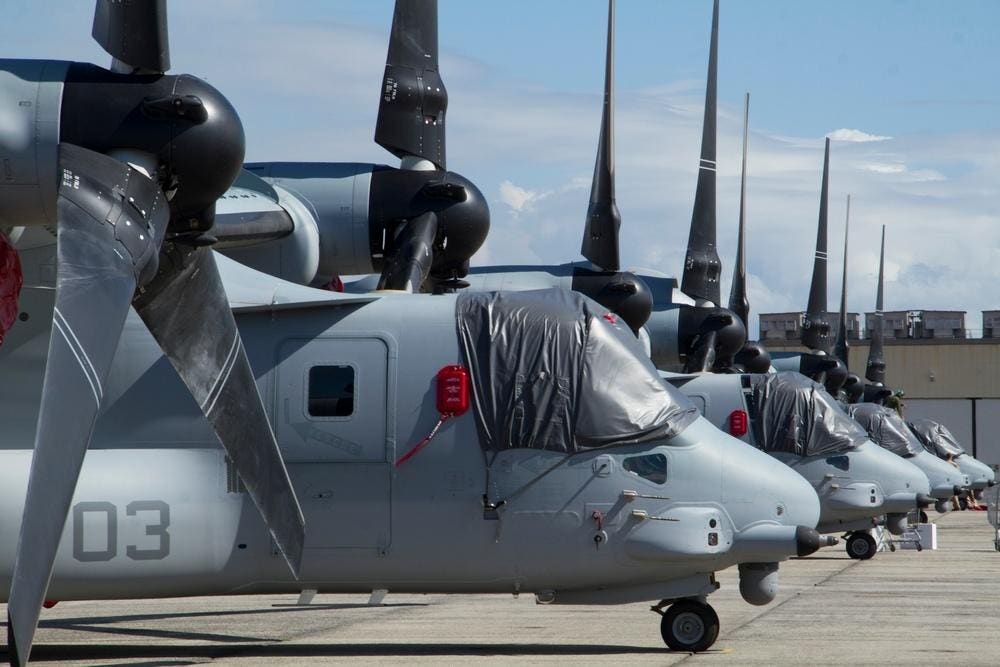It’s been almost two months since the U.S. V-22 fleet was grounded. On Thursday the Marine Corps said the grounding is a safety issue for tiltrotor squadrons.
Ospreys of all types have been grounded since the crash of an Air Force Special Operations CV-22B off the coast of Japan in November. Assistant Commandant of the Marine Corps, General Chris Mahoney, expressed the Corps’ concern about returning to flying during an event at the Washington DC-based Hudson Institute.
U.S. Naval Institute News reported that with no timeline for ending the grounding of the V-22 fleet in sight, Gen. Mahoney observed that the perishable flying skills and maintenance skills required to keep the complex aircraft operational are withering.
“At some point, if a pilot doesn’t fly if a maintainer doesn’t turn a wrench, if an observer or crew chief isn’t plying their trade it becomes a competence issue and then there’s a safety issue,” Mahoney said.
That issue becomes bigger the longer the grounding persists. If it continues, the time required to refresh V-22 aircrew and support personnel will grow, further extending the operational pause for America’s Ospreys. The problem stretches across the Marine Corps, Air Force and Navy.
I recently noted the impact on the latter which has been forced to revert to using the C-2 Greyhound to fill the carrier onboard delivery role that grounded Navy CMV-22s cannot currently fulfill in the Pacific Fleet.
The Marines are substituting CH-53E Sea Stallion heavy-lift helicopters for their grounded MV-22s. The Sea Stallions are operating with the 26th Marine Expeditionary Unit currently deployed with the Bataan Amphibious Ready Group which has been plying the waters of the Red Sea, Strait of Hormuz and Mediterranean as tensions in the Middle East have erupted following the Israel-Hamas war.
I queried the Air Force about what assets it is using to backfill in the absence of its special operations CV-22Bs. The likely choice would be its fleet of HH-60G/W Pave Hawk search and rescue helicopters which could take on some of the special operations airlift that CV-22Bs are tasked with.
The full grounding went into effect on December 6, after which Naval Air Systems Command (NAVAIR) released a statement affirming that the “preliminary investigation information indicates a potential material failure caused the mishap, but the underlying cause of the failure is unknown at this time.”
Well over a month later, no revelations pinpointing the exact cause have been released by the Services. In his Hudson Institute remarks, Gen. Mahoney said the hard clutch tilt-rotor engagement that was assessed as the cause of two earlier Marine V-22 crashes had been largely solved with the timed replacement of a specific drive-train component according to USNI News.
This evening, Lieutenant Colonel Rebecca L. Heyse, director of public affairs for Air Force Special Operations Command (AFSOC) said via email that the Service has no updates to provide but remains in close contact with the V-22 Joint Program Office.
“Maintainers and aircrew continue to conduct ground-based training and activities to the maximum extent possible,” she added. “Additionally, our crews have access to simulators to maintain as much readiness as they can in them. Engine runs and other maintenance activities are authorized during the stand down and we have been executing those.”
When V-22s are again allowed to fly, each service will require specific processes for reintroducing personnel to the tiltrotor’s operation and a review of findings and input from the stand down. In 2022, the Corps’ released an Aviation Safety Stand Down Guidance following a slate of six aircraft accidents across the Service in the previous six months.
The guidance required that unit commanders refresh safety policies and standards, review and discuss historical mishap examples, and provide feedback to investigators. Units were to revisit “Bottom up” tech training using junior Marines to help demonstrate documentation, checklist use, and more.
A reintroduction of Type/Model/Series performance characteristics, aircrew workload, NATOPS limits, and task saturation charts to squadron Ready Rooms and mission planning cells was required as well. Crew Resource Management reviews were required and operational tempo versus safety evaluations were mandated.
The above offer some idea of what faces Marine and other V-22 squadrons before they can return to flying the Osprey. As Gen. Mahoney pointed out, their skills are atrophying and with every day that passes the workload to regain them increases.
Read the full article here





